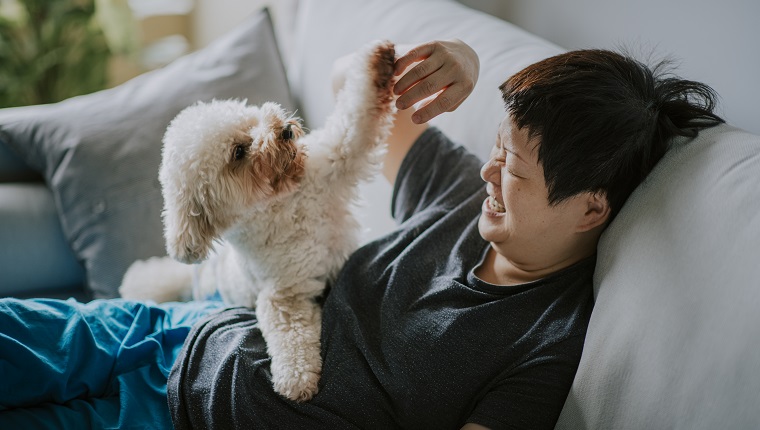Thankfully, the days are mostly gone when an allergic person was told to “just get rid of the dog.” Doctors now realize that many people would rather endure a little sniffling than live without a dog, and they can work with you to minimize your symptoms. But if your allergies aren’t that bad, don’t let pet allergies hold you back! You can still enjoy life with your pup, even if you’re allergic to dog dander.
The Causes Of Dog Allergies
Contrary to popular belief, dog hair doesn’t exactly cause allergies. It’s usually dog dander — tiny scales from animal hair, skin, or feathers — that gets people wheezing.
Dust and pollen often hitchhike on dander, making it even more allergenic. Some people are also allergic to dog saliva or urine.
Because dander is the true culprit, the idea that low-shedding dogs are hypoallergenic isn’t really true. All dogs have dander, even hairless ones. Low-shedding dogs tend to release less of it than heavy shedders, but they can still cause an allergic reaction.
You may be allergic to all dog dander or just to some breeds, or to some dogs in one breed but not others. The only way to know how you’ll react to a specific dog is to spend time with them.
How To Reduce Your Allergies

Ideally, the first step is to make sure that dogs are really what’s causing the problem. The only way to do that is to live without dogs — in a home that’s dander-free — for two months and see how you feel.
If you’re truly allergic, the following tips may give you some relief:
- Most importantly, don’t let your dog sleep in your bedroom, and never in your bed. Keep the door closed, and clean the room thoroughly.
- Animal allergens are sticky, so regularly remove the dog’s bed, pull up rugs, and scrub the walls, floors, and woodwork.
- If possible, go with bare floors instead of allergen-trapping carpeting. If you don’t like bare floors, use throw rugs that can be washed in hot water.
- Vacuum often, and wear a dust mask when you do it. Invest in a good vacuum with a HEPA filter.
- Cover your vents with cheesecloth, at least the ones in your bedroom.
- Keep your dog off furniture or cover it with fabric that you wash frequently in hot water.
- Forced-air heating and air conditioning can spread allergens, so add an air cleaner with a HEPA filter to central heating and air conditioning, and run it at least four hours a day. An electrostatic filter will also remove airborne particles the size of animal allergens.
- Washing the dog may reduce allergens in your dog’s fur, but it may not help your symptoms. Have a friend or groomer do it if it makes you wheezy or sneezy.
- Have someone else brush your dog outside.
See an allergist if you have asthma or significant allergies. An allergist can give you shots to reduce your sensitivity to dander, but be aware, they can get expensive, and it takes a long time to complete enough shots to make a difference.
When It’s Time To See A Vet
Your dog’s dry skin can cause irritation and itchiness, which in turn causes extra scratching, which releases more dander than usual. So, keeping your dog’s skin healthy can help your allergies.
Many conditions cause a dog’s skin to dry out, such as mange, metabolic disorders, hormonal disorders, allergies to fleas and dust mites, hot spots, and most kinds of dermatitis. Your vet can help you diagnose and treat the problem.
Here are some tactics you can try on your own as well:
- Have a friend or groomer brush the dog regularly to release more oil into their coat.
- Add essential fatty acids to their diet.
- Go with high-quality, healthy dog food, not the cheap stuff.
- Only bathe your dog when necessary using a moisturizing dog shampoo, not human shampoo.
- Try sprays or wipes that reduce dander on your dog.
If You’re Looking For A New Dog

The following breeds tend to be easier on people with allergies, according to the American Kennel Club:
- Bedlington Terrier
- Bichon Frise
- Chinese Crested
- Irish Water Spaniel
- Kerry Blue Terrier
- Maltese
- Poodle (any size)
- Portuguese Water Dog
- Schnauzer (any size)
- Soft Coated Wheaten Terrier
- Xoloitzcuintli
Still, remember that the only way to tell if you’re going to react to a dog is to spend time with that particular dog and watch for reactions. And of course, if it’s saliva or urine you’re allergic to, any kind of dog may provoke an allergic reaction.
Do you have dog allergies and still live with a canine pal? How do you reduce your allergic reactions? Let us know in the comments below!









